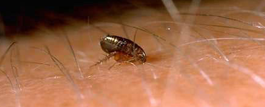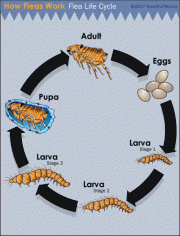
Interesting fact about fleas is that they do not bite humans! Pet fleas only bite pets – dogs, cats etc. Their mouth parts are not designed to bite/pierce human skin, sure they cause irritation and you start scatching.
Fleas respond to vibration when you enter the room. They only start jumping as they sence a possible target to feed on!
Fleas can only jump 150 – 200 mm and once on you they cannot jump any higher, only crawl higher up your leg. All they can do is jump off and fall to the ground. So most fleas when found on humans are found well below the knee, unless infesting couches chairs, beds etc.
There are four stages that make up the life cycle of a flea – egg, larva, pupa and imago or adult.
 The eggs of a flea are tiny, white and oval-shaped. A female flea can lay up to 600 eggs in her lifetime. They are most often laid on the host in batches of up to 50. The eggs can easily roll off of the host and on to the ground, making the areas where the host sleeps, rests or nests a primary location for eggs and developing fleas. An egg may take from two days to two weeks to hatch.
The eggs of a flea are tiny, white and oval-shaped. A female flea can lay up to 600 eggs in her lifetime. They are most often laid on the host in batches of up to 50. The eggs can easily roll off of the host and on to the ground, making the areas where the host sleeps, rests or nests a primary location for eggs and developing fleas. An egg may take from two days to two weeks to hatch.A typical flea population consists of 50% eggs, 35% larvae, 10% pupae and 5% adults with this population developing best under warm, moist conditions. Under ideal conditions, ten female fleas can multiply to over a quarter million fleas of different life stages, in just 30 days!
 DOES YOUR DOG HAVE FLEAS?
DOES YOUR DOG HAVE FLEAS?